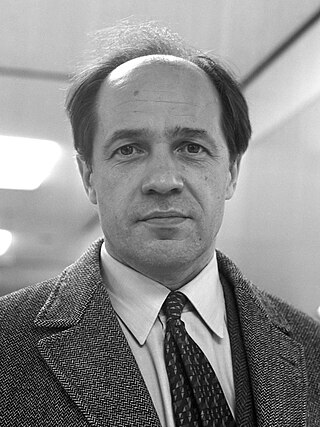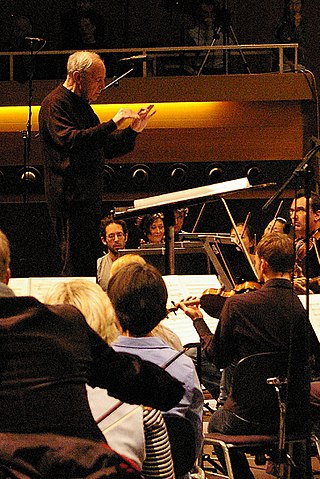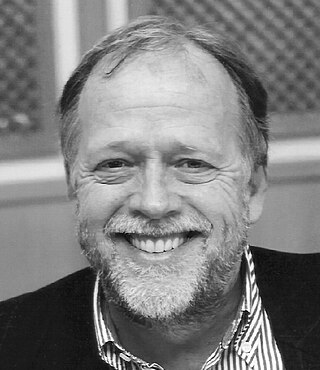
Pierre Louis Joseph Boulez was a French composer, conductor and writer, and the founder of several musical institutions. He was one of the dominant figures of post-war Western classical music.
Kreuzspiel (Crossplay) is a composition by Karlheinz Stockhausen written for oboe, bass clarinet, piano and four percussionists in 1951. It is assigned the number 1/7 in the composer's catalogue of works.
Polyphonie X (1950–51) is a three-movement composition by Pierre Boulez for eighteen instruments divided into seven groups, with a duration of roughly fifteen minutes. Following the work's premiere, Boulez withdrew the score, stating that it suffered from "theoretical exaggeration". Despite Boulez's dissatisfaction with the piece, it played a key role in his development: one writer called it "the linchpin connecting Boulez's early mastery of gesture and contour... with his later interest in large ensembles and grand forms", his "brave 'first attempt' to produce a work that exhausted a particular musical technique with large orchestral forces by developing an expansive, additive structure at the earliest stages of composition", and "one of the purest representations of Boulez's first turn toward integral serialism".

Mantra is a composition by the German composer Karlheinz Stockhausen. It was composed in 1970 and premiered in autumn of the same year at the Donaueschingen Festival. The work is scored for two ring-modulated pianos; each player is also equipped with a chromatic set of crotales and a wood block, and one player is equipped with a short-wave radio producing morse code or a magnetic tape recording of morse code. In his catalogue of works, the composer designated it as work number 32.
Anthèmes are two related compositions for violin by French composer Pierre Boulez: Anthèmes I and Anthèmes II.

Le Marteau sans maître is a chamber cantata by French composer Pierre Boulez. The work, which received its premiere in 1955, sets surrealist poetry by René Char for contralto and six instrumentalists. It is among his most acclaimed compositions.
Pierre Boulez composed three piano sonatas: the First Piano Sonata in 1946, the Second Piano Sonata in 1947–48, and the Third Piano Sonata in 1955–57 with further elaborations up to at least 1963, though only two of its movements have been published.

Rituel in memoriam Bruno Maderna (1974–75) is a composition for orchestra in eight groups by Pierre Boulez. Biographer Dominique Jameux wrote that the piece has "obvious audience appeal", and that it represented a desire to establish "immediate, almost physical contact with the public". Jameux also noted that Rituel represents one of the few examples of repetitive music written by Boulez. Author Jonathan Goldman wrote that, of Boulez's works, Rituel is the one that "most evokes... the sound worlds of non-Western musical ensembles, be they Indonesian, African or South American."

Atmosphères is a piece for orchestra, composed by György Ligeti in 1961. It is noted for eschewing conventional melody and metre in favor of dense sound textures. After Apparitions, it was the second piece Ligeti wrote to exploit what he called a "micropolyphonic" texture. It gained further exposure after being used in Stanley Kubrick's film 2001: A Space Odyssey.
Martin Smolka is a contemporary Czech composer of classical music.

The Donaueschingen Festival is a festival for new music that takes place every October in the small town of Donaueschingen in south-western Germany. Founded in 1921, it is considered the oldest festival for contemporary classical music in the world, and among the best-known and most prestigious.

Aloys and AlfonsKontarsky were German duo-pianist brothers who were associated with a number of important world premieres of contemporary works. They had an international reputation for performing modern music for two pianists, although they also performed the standard repertoire and they sometimes played separately. They were occasionally joined by their younger brother Bernhard in performances of pieces for three pianos. After suffering a stroke in 1983, Aloys retired from performing.

Michael Obst is a German composer and pianist.

Punkte (Points) is an orchestral composition by Karlheinz Stockhausen, given the work number ½ in his catalogue of works.
Quatre Études de rythme is a set of four piano compositions by Olivier Messiaen, written in 1949 and 1950. A performance of them lasts between 15 and 20 minutes.
Spiel is a two-movement orchestral composition by Karlheinz Stockhausen, written in 1952. Withdrawn by the composer after its first performance, it was later revised and restored to his catalogue of works, where it bears the work-number ¼. The score is dedicated to the composer's first wife, Doris.
"Epitaphium" is a short chamber-music composition by Igor Stravinsky, for flute, clarinet, and harp. The score was composed in 1959 and is inscribed in German, "Für das Grabmal des Prinzen Max Egon zu Fürstenberg". A performance last for less than two minutes.
Yukiko Sugawara is a Japanese pianist born in Sapporo.
Christoph Staude is a German composer.
Réveil des oiseaux is a work by Olivier Messiaen for piano and orchestra written in 1953. Messiaen invoked birdsong in this composition, as he had in the earlier Quatuor pour la fin du temps (1941). In Réveil des oiseaux he used bird song motifs throughout.
![Olivier Messiaen's Mode de valeurs et d'intensites highest of three unordered divisions of the mode,( or, less precisely, "three series forms [caption: 'for pitch, duration, dynamics, and articulation']...treated as unordered collections", --which Boulez, "the pupil intending to teach the master a lesson", adapted as an ordered series for his Structures Ia. Messiaen - Mode de valeurs et d'intensites series upper line -- Boulez - Structures Ia.png](http://upload.wikimedia.org/wikipedia/en/thumb/f/fd/Messiaen_-_Mode_de_valeurs_et_d%27intensites_series_upper_line_--_Boulez_-_Structures_Ia.png/440px-Messiaen_-_Mode_de_valeurs_et_d%27intensites_series_upper_line_--_Boulez_-_Structures_Ia.png)





